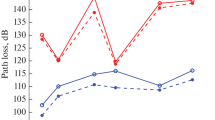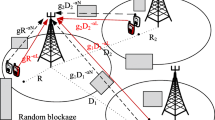Abstract
Behavior of co-channel interference in fixed wireless cellular systems, such as millimeter-waves Local Multipoint Distribution Service (LMDS), is different compared to what has been established for mobile microwave systems. This is due to utilization of a high-gain antenna for the subscriber. In this paper, first the analysis of signal-to-interference ratio (SIR) is presented for line-of-sight and nearly line-of-sight LMDS architecture. In this analysis, the effects of precipitation and foliage attenuation and depolarization have been considered. These two parameters have negligible effect on the microwave mobile systems but in millimeter-wave range are among the most important factors in the link budget. To mitigate the fading due to shadowing by buildings and trees, a highly overlapped architecture and macro-diversity are proposed. After analysis of downlink SIR in previously proposed cellular systems, a cellular architecture is proposed based on polarization interleaving and frequency segmentation which has a much higher SIR yield. The statistical assessment of SIR is accomplished by assuming lognormal distribution for the received signals.
Similar content being viewed by others
REFERENCES
E. J. Voilette, R. H. Espeland, R. O. DeBolt, F. Schwering, “Millimeter-wave propagation at street level in an urban environment,” IEEE Trans. on Geoscience and Remote Sensing, Vol. 26, No. 3, pp. 368–380, May 1988.
F. K. Schwering, E. J. Voilette, R. H. Espeland, “Millimeter-wave propagation in vegetation: experiments and theory,” IEEE Trans. on Geoscience and Remote Sensing, Vol. 26, No. 3, pp. 355–367, May 1988.
P. Papazian, G. A. Hufford, R. J. Achatz, R. Hoffman, “Study of the local multipoint distribution service radio channel,” IEEE Trans. on Broadcasting, Vol. 43, No. 2, pp. 175–184, June 1997.
R. A. Dalke, G. A. Hufford, R. L. Ketchum, “Radio consideration for local multipoint distribution systems,” NTIA Report 96–331, Aug. 1996.
S. Martin, W. Myers, D. Burt, “Medium range terrestrial propagation study at 28 GHz,” SPIE Proc. 3232, Wireless Techniques and Systems: Millimeter-wave and optical, pp. 33–43, Nov. 1997.
S. Y. Siedel, H. W. Arnold, “Propagation measurement at 28 GHz to investigate the performance of local multipoint distribution service,” Proc. IEEE Globcom 95, Vol. 1, pp. 754–757, Nov. 1995.
D. C. Cox, “Co-channel interference considerations in frequency reuse small-coverage-area radio systems,” IEEE Trans. on Communications, Vol. 30, No. 1, pp. 135–142, Jan. 1982.
P. A. Gray, “A broadband wireless access system at 28 GHz,” Proc. IEEE Wireless Comm. Conf. 97, pp. 1–7, Aug. 1997.
P. A. Gray, “Optimal hub deployment for 28 GHz LMDS system,” Proc. IEEE Wireless Comm. Conf. 97, pp. 18–22, Aug. 1997.
S. C. Schwartz and Y. Yeh, “On the distribution function and moments of power sums with lognormal components,” BSTJ, Vol. 61, No. 7, pp. 1441–1462, Sept. 1982.
Y. Yeh, J. Wilson, and S. C. Schwartz, “Outage probability in mobile telephony with directive antennas and macrodiversity,” IEEE JSAC, Vol., No. 7, pp. 1441–1462, Sept. 1982.
N. C. Beauleiu, A. A. Abu-Dayya, P. J. McLane, “Estimating the distribution of a sum of independent lognormal random variables,” IEEE Trans. on Comm., Vol. 43, No. 12, pp. 286–2873, Dec. 1995.
R. C. Bernhardt, “Macroscopic diversity in frequency reuse radio systems,” IEEE JSAC, Vol. 5, No. 5, pp. 862–870, June 1987.
R. C. Bernhardt, “RF performance of macroscopic diversity in universal digital portable radio communication: signal strength considerations,” Proc. IEEE Globecom' 85, Vol. 2, pp. 1002–1007, Dec. 1985.
P. S. Henry, B. S. Glance, “A new approach to high-capacity digital mobile radio,” BSTJ, Vol. 60, No. 8, pp. 1891–1904, Oct. 1981.
C. H. Hendrix, G. Kulon, C. S. Anderson, and M. A. Heinze, “Multigigabit transmission through rain in a dual polarization frequency reuse system: an experimental study,” IEEE Trans. On Commu., Vol. 41, No. 12, pp. 1830–1837, Dec. 1993.
D. V. Rogers, L. J. Ippolito, F. Davarian, “System requirement for Ka-band earth-satellite propagation data,” Proc. of IEEE, Vol. 85, No. 6, pp. 810–820, June 1997.
S. Farahvash, and M. Kavehrad, “A Statistical channel model for millimeter-waves propagation in LMDS applications,” Proceedings of IEEE PIMRC' 99, JAPAN, September 1999.
J. G. Proakis, Digital Communications, Third Edition, McGraw Hill, New York, 1995.
W. C. Jakes, Microwave Mobile Communications, J. Wiley and Sons, New York, 1974.
Author information
Authors and Affiliations
Rights and permissions
About this article
Cite this article
Farahvash, S., Kavehrad, M. Co-channel Interference Assessment for Line-of-Sight and Nearly Line-of-Sight Millimeter-Waves Cellular LMDS Architecture. International Journal of Wireless Information Networks 7, 197–210 (2000). https://doi.org/10.1023/A:1009592106492
Issue Date:
DOI: https://doi.org/10.1023/A:1009592106492




